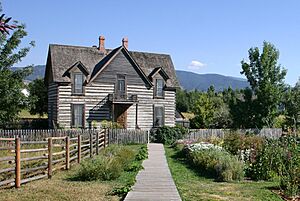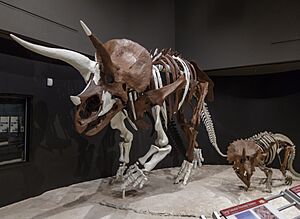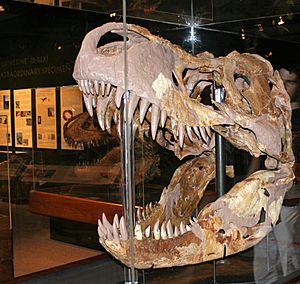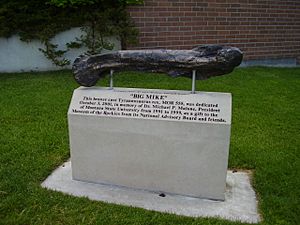Museum of the Rockies facts for kids
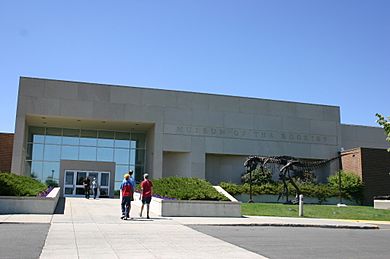
Museum of the Rockies front entrance.
|
|
| Established | 1957 |
|---|---|
| Location | 600 W. Kagy Boulevard, Bozeman, Montana, United States |
| Type | General History Museum |
The Museum of the Rockies is an exciting museum located in Bozeman, Montana. It's connected with Montana State University and also the famous Smithsonian Institution. This museum is super famous for its amazing collection of dinosaur fossils, especially those found in North America. In fact, it has the biggest collection of North American dinosaur fossils in the entire United States!
You can see the largest Tyrannosaurus skull ever found here. Plus, they have a Tyrannosaurus rex thigh bone that still contains soft tissue! The museum is part of the Montana Dinosaur Trail. It's also Montana's official place for keeping important fossil finds.
The museum's collections tell the story of the Rocky Mountains. They show what life was like for people and animals there over 500 million years ago. Some cool exhibits you can explore include:
- "History of the Northern Rocky Mountain Region": This exhibit covers everything from Native Americans and fur traders to gold seekers and settlers, right up to World War II.
- The Living History Farm: Here, you'll find the Tinsley House. People dressed in old-fashioned clothes show you what life was like in a home from the early 1900s.
- The Taylor Planetarium: This is a huge dome theater, about 40 ft (12 m) wide, where you can watch amazing shows about space.
Contents
Discovering Montana's Past
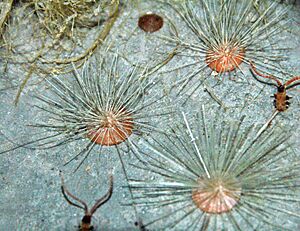
The Museum of the Rockies helps us understand the history of Montana and the Northern Rockies. It teaches visitors about the area's rich past, including its incredible dinosaur history. The museum first opened in 1957, thanks to a gift from Caroline M. McGill.
Since then, the museum's collection has grown to include 300,000 objects! These items cover more than 500 million years of history. In 1980, the museum received over 10,000 old photographs and negatives. These pictures, known as the Schlechten collection, show life in Bozeman and Yellowstone National Park from about 1905 to the late 1970s.
The museum also hosts special events where Native Americans share their oral histories with visitors. This helps everyone learn about the tribes who lived in the region long ago. In 2005, the museum became connected with the Smithsonian Institution. This means the museum can now share even more cool collections and programs with its visitors.
The museum often has special traveling exhibits. These have covered many different topics, like African American art, movie costumes, and even ancient Egyptian treasures like King Tut.
Exploring the Museum
The Tinsley House
The Tinsley House is a special part of the Museum of the Rockies. It's like a living history museum where you can step back in time. This house is over 100 years old! It was originally in Willow Creek, Montana, but it was moved to the museum's grounds in 1989. The museum grounds cover more than 10 acres (40,000 m2).
At the Tinsley House, you can learn about the Tinsley family and what life was like for people in the late 1800s. The house even has a working outhouse, a water pump, and a kitchen just like they used to have.
The Tinsleys moved west during the American Civil War. William and Lucy Tinsley met in Virginia City, Montana, and later moved to the Gallatin Valley after they got married. They built their house in 1889 because their first cabin was too small for their growing family. The house shows what it was like to live on a homestead in the Gallatin Valley during the 1800s. The logs for the house were collected over two years from the Tobacco Root Mountains.
Amazing Dinosaurs and Fossils
Even though the museum has many different things, it's most famous for its dinosaur and fossil collections. For a long time, fossils found in Montana were sent to museums in other states. But this changed in 1990 when a Tyrannosaurus Rex skeleton was found. This amazing find stayed in Montana and is now shown at the museum!
Even though fossils belong to the federal government, the museum has been able to grow its collection. This is partly thanks to Curator Jack Horner and his work with the United States Fish and Wildlife Service and the Federal Bureau of Land Management. The museum now has 13 Tyrannosaurus Rex specimens! This includes one of only two complete T. rex skeletons ever found.
The Museum of the Rockies has one of the largest collections of dinosaur fossils in the world, and the biggest in the United States. It's also home to one of the world's largest Tyrannosaurus skulls (MOR 008). This skull is even a little bigger than "Sue," the famous T. rex at the Chicago Field Museum.
The museum's Siebel Dinosaur Complex has an exciting discovery: one of the first identified female dinosaurs, an ovulating T. rex! Curator Horner, who helped with the Jurassic Park movies, was also a lead scientist in a big discovery in 2005. They found soft tissue remains inside a Tyrannosaurus thigh bone, which were later brought to the museum.
The museum has been involved in many other cool finds. These include a baby Triceratops found in Jordan, Montana, in 2006. They also found "Yoshi's Trike" (MOR 3027) in 2010, which is a huge Triceratops with horns that are 125 cm long!
In June 2008, the museum helped get a special mobile paleontology lab. This lab helps researchers analyze fossils right in the field. This stops the fossils from breaking down before they even get to the museum.
In 2017, the museum finished its new Curatorial Center for the Humanities. This meant that many history items were moved to the new building. This gave the Paleontology department about 11,000 square feet (1,000 m2) more space in the museum's basement to store even more fossils!
Curatorial Center for the Humanities
On April 28, 2016, the museum started building a new center called the Curatorial Center for the Humanities (CCH). This new building cost $4 million and is 20,000-square-foot (1,900 m2) big. It was built to store and care for the museum's collections related to human history. This includes art, old tools from archaeological digs, historical items, Native American artifacts, and photographs.
The CCH was finished in 2017. About 13,000 square feet (1,200 m2) of the building is for storage. The other 7,000 square feet (650 m2) is for offices and work areas. Private donations paid for the entire building, so no state money was used. Slate Architecture from Helena designed the building. Bill Walker was the main architect. Other companies helped with the engineering, structural engineering, and planning for the electrical, mechanical system, and plumbing systems. The main builder was Jackson Contractor Group from Bozeman.
Learning and Education
Students from all over Montana can visit the museum for school tours. There are also special programs for homeschoolers, fun summer camps, and educational classes and lectures. Even students from Montana State University can take classes here. They can do research, learn about museum practices, and even do independent studies with the museum.
See also
 In Spanish: Museo de las Rocosas para niños
In Spanish: Museo de las Rocosas para niños


